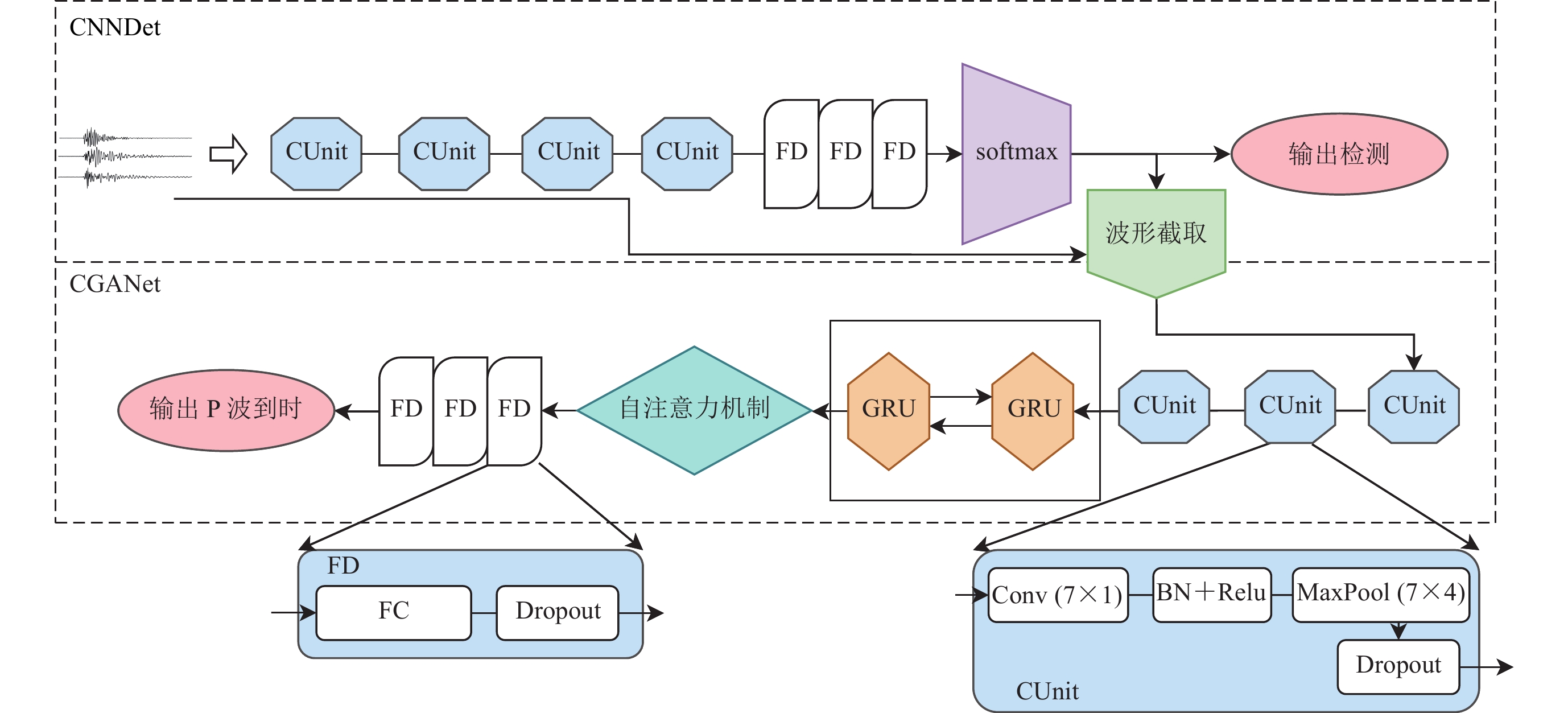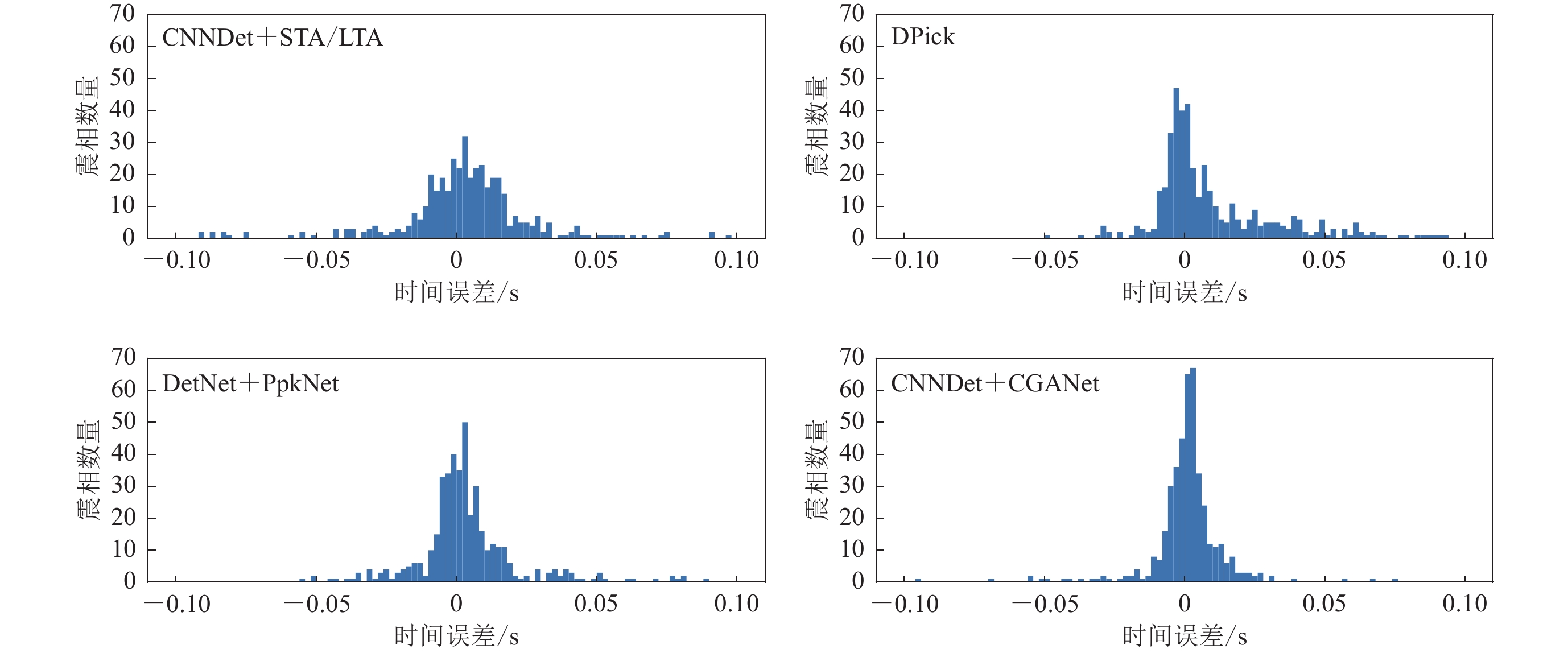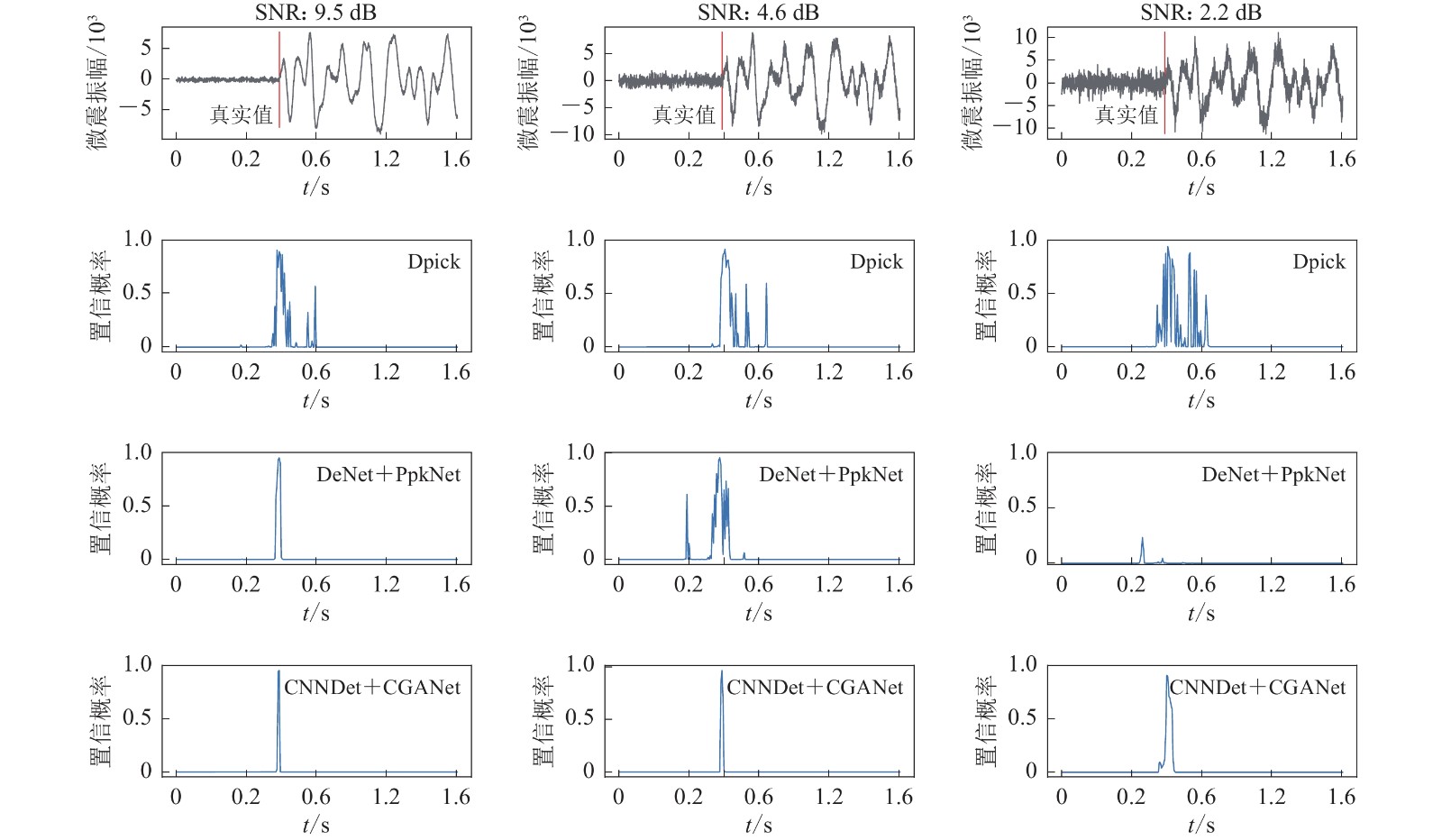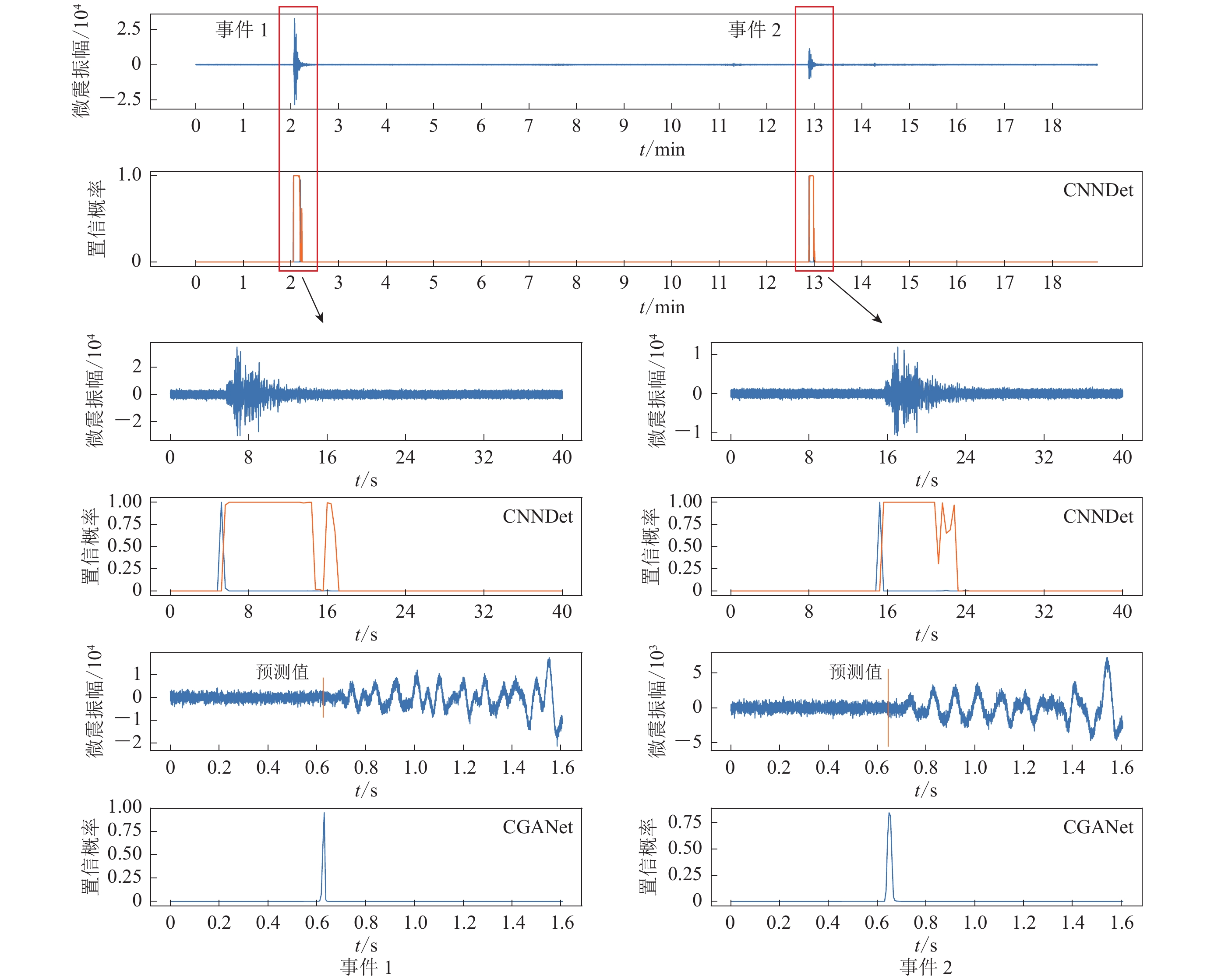P-arrival picking method of mine microseisms by fusing of GRU and self-attention mechanism
-
摘要: 基于深度学习方法提出了一种矿山微震P波到时拾取方法。首先构建CNNDet模型进行事件监测和到时预拾取;其次引入自注意力机制,融合门控循环单元(GRU)构建CGANet模型,对检测到的事件进行P波到时精确拾取;最后将该方法与长短时窗能量比法、DPick和PpkNet方法进行对比,结果显示测试集的事件检测精确率和召回率都达到98%以上,P波到时估计的误差均值和标准差分别为0.014 s和0.051 s,说明本文方法在精确率、召回率及标准差等方面均明显优于上述三种方法。此外,对不同信噪比样本进行测试的结果也证明,本文方法在低信噪比下依然能保持较高的精度。在实际震源定位中,该方法也展现出了更优异的性能。Abstract: Seismic phase picking is the first key step of mine microseisms detection, and its accuracy often directly affects the quality of subsequent event processing, so we proposed a method for P-arrival picking of mine microseisms which is based on deep learning method. Firstly the CNNDet model is constructed for events detection and P-arrival pre-picking, and then the CGANet model was constructed to accurately pick up the P-arrival time for the detected events by introducing the self-attention mechanism and the gated recurrent unit. Comparison with STA/LTA, DPick and PpkNet shows that the precision and the recall ratio of seismic event detection by our method are more than 98% for the test sets, and the mean error and the standard deviation of P-arrival are 0.014 s and 0.051 s, respectively. Our method is superior to the above three methods in terms of precision, the recall ratio and the standard deviation. In addition, the experimental tests on samples with different SNRs prove that our method can still maintain high precision on the condition of low SNR. In the source location, our method also shows more excellent performance. The P-arrival picking method proposed in this paper which is based on gated recurrent unit and self-attention mechanism provides a new idea for microseisms monitoring and accurate identification of rock burst and other disasters.
-
-
表 1 本文方法与STA/LTA,DPick和PpkNet的性能比较
Table 1 The performance of the proposed method in this study compared with STA/LTA,DPick and PpkNet
方法 精确率 召回率 平均绝对误差/s 标准差/s 误差>0.2 s占比 CNNDet+STA/LTA 0.724 0 0.724 0 0.028 115 0.086 968 2.28% DPick 0.854 6 0.847 0 0.027 957 0.060 322 2.74% DetNet+PpkNet 0.878 0 0.871 0 0.019 124 0.051 418 1.36% CNNDet+CGANet 0.948 0 0.948 0 0.014 158 0.051 052 1.14% -
陈光波,滕鹏程,李谭,王创业,陈世江,张国华. 2021. 煤矿冲击地压评价模型及其应用[J]. 太原理工大学学报,52(6):966–973. Chen G B,Teng P C,Li T,Wang C Y,Chen S J,Zhang G H. 2021. Evaluation model of rock burst in coal mine and its application[J]. Journal of Taiyuan University of Technology,52(6):966–973 (in Chinese).
陈泽,丁琳琳,罗浩,宋宝燕,张明,潘一山. 2020. 基于改进小波分解和ELM的矿山微震事件识别方法[J]. 煤炭学报,45(增刊):637–648. Chen Z,Ding L L,Luo H,Song B Y,Zhang M,Pan Y S. 2020. Mine microseismic events classification based on improved wavelet decomposition and ELM[J]. Journal of China Coal Society,45(S2):637–648 (in Chinese).
付继华,王旭,李智涛,谭巧,王建军. 2019. 强噪声环境下基于信噪比的地震P波到时自动提取方法[J]. 地球物理学报,62(4):1405–1412. Fu J H,Wang X,Li Z T,Tan Q,Wang J J. 2019. Automatic picking up earthquake’s P waves using signal-to-noise ratio under a strong noise environment[J]. Chinese Journal of Geophysics,62(4):1405–1412 (in Chinese).
李安,杨建思,彭朝勇,郑钰,刘莎. 2020. 基于样本增强的卷积神经网络震相拾取方法[J]. 地震学报,42(2):163–176. Li A,Yang J S,Peng C Y,Zheng Y,Liu S. 2020. Seismic phase identification using the convolutional neural networks based on sample enhancement[J]. Acta Seismologica Sinica,42(2):163–176 (in Chinese).
李长洪,张吉良,蔡美峰,张磊,林清华. 2009. 煤矿冲击性灾害类型实验研究[J]. 北京科技大学学报,31(1):1–9. Li C H,Zhang J L,Cai M F,Zhang L,Lin Q H. 2009. Simulating test research of impacting disasters in coal mines[J]. Journal of University of Science and Technology Beijing,31(1):1–9 (in Chinese).
李宇,韩晓红,张玲,张海轩,李钢. 2023. 融合时空注意力机制的P波到时拾取网络[J]. 计算机工程与应用,59(6):113–124. Li Y,Han X H,Zhang L,Zhang H X,Li G. 2023. Seismic P-wave first-arrival pickup model based on spatiotemporal attention mechanism[J]. Computer Engineering and Applications,59(6):113–124 (in Chinese).
王议迎,丁仁伟,李建平,赵俐红,赵硕,张硕伟. 2021. 联合改进STA/LTA与MLoG算子的微震P波到时自动拾取方法[J]. 山东科技大学学报(自然科学版),40(6):1–10. Wang Y Y,Ding R W,Li J P,Zhao L H,Zhao S,Zhang S W. 2021. Automatic pickup of microseismic P-wave arrival based on improved STA/LTA and MLoG operators[J]. Journal of Shandong University of Science and Technology (Natural Science),40(6):1–10 (in Chinese).
张逸伦,喻志超,胡天跃,何川. 2021. 基于U-Net的井中多道联合微地震震相识别和初至拾取方法[J]. 地球物理学报,64(6):2073–2085. Zhang Y L,Yu Z C,Hu T Y,He C. 2021. Multi-trace joint downhole microseismic phase detection and arrival picking method based on U-Net[J]. Chinese Journal of Geophysics,64(6):2073–2085 (in Chinese).
赵洪宝,刘瑞,顾涛,刘一洪,蒋冬梅. 2021. 基于深度学习模式的微震信号P波自动拾取方法研究[J]. 岩石力学与工程学报,40(增刊):3084–3097. Zhao H B,Liu R,Gu T,Liu Y H,Jiang D M. 2021. Research on automatic picking method of microseismic signal P wave based on deep learning mode[J]. Chinese Journal of Rock Mechanics and Engineering,40(S2):3084–3097 (in Chinese).
赵明,陈石,房立华,Yuen D A. 2019. 基于U形卷积神经网络的震相识别与到时拾取方法研究[J]. 地球物理学报,62(8):3034–3042. Zhao M,Chen S,Fang L H,Yuen D A. 2019. Earthquake phase arrival auto-picking based on U-shaped convolutional neural network[J]. Chinese Journal of Geophysics,62(8):3034–3042 (in Chinese).
周飞燕,金林鹏,董军. 2017. 卷积神经网络研究综述[J]. 计算机学报,40(6):1229–1251. doi: 10.11897/SP.J.1016.2017.01229 Zhou F Y,Jin L P,Dong J. 2017. Review of convolutional neural network[J]. Chinese Journal of Computers,40(6):1229–1251 (in Chinese).
Akaike H. 1974. A new look at the statistical model identification[J]. IEEE Trans Automat Contr,19(6):716–723. doi: 10.1109/TAC.1974.1100705
Allen R. 1982. Automatic phase pickers:Their present use and future prospects[J]. Bull Seismol Soc Am,72(6B):S225–S242. doi: 10.1785/BSSA07206B0225
Chen B R,Feng X T,Li S L,Yuan J P,Xu S C. 2009. Microseism source location with hierarchical strategy based on particle swarm optimization[J]. Chin J Rock Mech Eng,28(4):740–749.
Dai H C,Macbeth C. 1995. Automatic picking of seismic arrivals in local earthquake data using an artificial neural network[J]. Geophys J Int,120(3):758–774. doi: 10.1111/j.1365-246X.1995.tb01851.x
Dai H C,Macbeth C. 1997. The application of back-propagation neural network to automatic picking seismic arrivals from single-component recordings[J]. J Geophys Res:Solid Earth,102(B7):15105–15113. doi: 10.1029/97JB00625
Dubey A C, Barnard R L. 1997. Detection and Remediation Technologies for Mines and Minelike Targets II[M]. Orlando, Florida: SPIE: 21–24.
Grayson R L,Kinilakodi H,Kecojevic V. 2009. Pilot sample risk analysis for underground coal mine fires and explosions using MSHA citation data[J]. Saf Sci,47(10):1371–1378. doi: 10.1016/j.ssci.2009.03.004
Mousavi S M,Ellsworth W L,Zhu W Q,Chuang L Y,Beroza G C. 2020. Earthquake transformer:An attentive deep-learning model for simultaneous earthquake detection and phase picking[J]. Nat Commun,11(1):3952. doi: 10.1038/s41467-020-17591-w
Perol T,Gharbi M,Denolle M. 2018. Convolutional neural network for earthquake detection and location[J]. Sci Adv,4(2):e1700578. doi: 10.1126/sciadv.1700578
Ronneberger O, Fischer P, Brox T. 2015. U-net: Convolutional networks for biomedical image segmentation[C]//18th International Conference on Medical Image Computing and Computer-Assisted Intervention. Munich: Springer: 234–241.
Saad O M,Chen Y K. 2021. Earthquake detection and P-wave arrival time picking using capsule neural network[J]. IEEE Trans Geosci Remote Sens,59(7):6234–6243. doi: 10.1109/TGRS.2020.3019520
Tang S B,Wang J X,Tang C N. 2021. Identification of microseismic events in rock engineering by a convolutional neural network combined with an attention mechanism[J]. Rock Mech Rock Eng,54(1):47–69. doi: 10.1007/s00603-020-02259-0
Ursano R J,Cerise F P,DeMartino R,Reissman D B,Shear M K. 2006. The impact of disasters and their aftermath on mental health[J]. J Clin Psychiatry,67(1):7–14. doi: 10.4088/JCP.v67n0102
Vaezi Y,van der Baan M. 2015. Comparison of the STA/LTA and power spectral density methods for microseismic event detection[J]. Geophys J Int,203(3):1896–1908. doi: 10.1093/gji/ggv419
Vaswani A, Shazeer N, Parmar N, Uszkoreit J, Jones L, Gomez A N, Kaiser Ł, Polosukhin I. 2017. Attention is all you need[C]//Proceedings of the 31st International Conference on Neural Information Processing Systems. Long Beach, California, USA: Curran Associates Inc.: 6000–6010.
Wang Y W,Li X J,Wang Z F,Shi J P,Bao E H. 2021. Deep learning for P-wave arrival picking in earthquake early warning[J]. Earthq Eng Eng Vib,20(2):391–402. doi: 10.1007/s11803-021-2027-6
Zhang J J,Tang Y L,Li H J. 2018. STA/LTA fractal dimension algorithm of detecting the P-wave arrival[J]. Bull Seismol Soc Am,108(1):230–237. doi: 10.1785/0120170099
Zhou Y J,Yue H,Kong Q K,Zhou S Y. 2019. Hybrid event detection and phase-picking algorithm using convolutional and recurrent neural networks[J]. Seismol Res Lett,90(3):1079–1087. doi: 10.1785/0220180319
Zhu W Q,Beroza G C. 2018. PhaseNet:A deep-neural-network-based seismic arrival time picking method[J]. Geophys J Int,216(1):261–273.





 下载:
下载:








